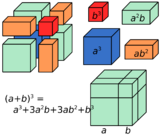Geometry of numbers
 From HandWiki - Reading time: 4 min
From HandWiki - Reading time: 4 min
Geometry of numbers is the part of number theory which uses geometry for the study of algebraic numbers. Typically, a ring of algebraic integers is viewed as a lattice in [math]\displaystyle{ \mathbb R^n, }[/math] and the study of these lattices provides fundamental information on algebraic numbers.[1] The geometry of numbers was initiated by Hermann Minkowski (1910). The geometry of numbers has a close relationship with other fields of mathematics, especially functional analysis and Diophantine approximation, the problem of finding rational numbers that approximate an irrational quantity.[2]
Minkowski's results
Suppose that [math]\displaystyle{ \Gamma }[/math] is a lattice in [math]\displaystyle{ n }[/math]-dimensional Euclidean space [math]\displaystyle{ \mathbb{R}^n }[/math] and [math]\displaystyle{ K }[/math] is a convex centrally symmetric body. Minkowski's theorem, sometimes called Minkowski's first theorem, states that if [math]\displaystyle{ \operatorname{vol} (K)\gt 2^n \operatorname{vol}(\mathbb{R}^n/\Gamma) }[/math], then [math]\displaystyle{ K }[/math] contains a nonzero vector in [math]\displaystyle{ \Gamma }[/math].
The successive minimum [math]\displaystyle{ \lambda_k }[/math] is defined to be the inf of the numbers [math]\displaystyle{ \lambda }[/math] such that [math]\displaystyle{ \lambda K }[/math] contains [math]\displaystyle{ k }[/math] linearly independent vectors of [math]\displaystyle{ \Gamma }[/math]. Minkowski's theorem on successive minima, sometimes called Minkowski's second theorem, is a strengthening of his first theorem and states that[3]
- [math]\displaystyle{ \lambda_1\lambda_2\cdots\lambda_n \operatorname{vol} (K)\le 2^n \operatorname{vol} (\mathbb{R}^n/\Gamma). }[/math]
Later research in the geometry of numbers
In 1930–1960 research on the geometry of numbers was conducted by many number theorists (including Louis Mordell, Harold Davenport and Carl Ludwig Siegel). In recent years, Lenstra, Brion, and Barvinok have developed combinatorial theories that enumerate the lattice points in some convex bodies.[4]
Subspace theorem of W. M. Schmidt
In the geometry of numbers, the subspace theorem was obtained by Wolfgang M. Schmidt in 1972.[5] It states that if n is a positive integer, and L1,...,Ln are linearly independent linear forms in n variables with algebraic coefficients and if ε>0 is any given real number, then the non-zero integer points x in n coordinates with
- [math]\displaystyle{ |L_1(x)\cdots L_n(x)|\lt |x|^{-\varepsilon} }[/math]
lie in a finite number of proper subspaces of Qn.
Influence on functional analysis
Minkowski's geometry of numbers had a profound influence on functional analysis. Minkowski proved that symmetric convex bodies induce norms in finite-dimensional vector spaces. Minkowski's theorem was generalized to topological vector spaces by Kolmogorov, whose theorem states that the symmetric convex sets that are closed and bounded generate the topology of a Banach space.[6]
Researchers continue to study generalizations to star-shaped sets and other non-convex sets.[7]
References
- ↑ MSC classification, 2010, available at http://www.ams.org/msc/msc2010.html, Classification 11HXX.
- ↑ Schmidt's books. Template:Cite Geometric Algorithms and Combinatorial Optimization
- ↑ Cassels (1971) p. 203
- ↑ Grötschel et al., Lovász et al., Lovász, and Beck and Robins.
- ↑ Schmidt, Wolfgang M. Norm form equations. Ann. Math. (2) 96 (1972), pp. 526–551. See also Schmidt's books; compare Bombieri and Vaaler and also Bombieri and Gubler.
- ↑ For Kolmogorov's normability theorem, see Walter Rudin's Functional Analysis. For more results, see Schneider, and Thompson and see Kalton et al.
- ↑ Kalton et al. Gardner
Bibliography
- Matthias Beck, Sinai Robins. Computing the continuous discretely: Integer-point enumeration in polyhedra, Undergraduate Texts in Mathematics, Springer, 2007.
- Enrico Bombieri; Vaaler, J. (Feb 1983). "On Siegel's lemma". Inventiones Mathematicae 73 (1): 11–32. doi:10.1007/BF01393823. Bibcode: 1983InMat..73...11B.
- Enrico Bombieri; Walter Gubler (2006). Heights in Diophantine Geometry. Cambridge U. P..
- J. W. S. Cassels. An Introduction to the Geometry of Numbers. Springer Classics in Mathematics, Springer-Verlag 1997 (reprint of 1959 and 1971 Springer-Verlag editions).
- John Horton Conway and N. J. A. Sloane, Sphere Packings, Lattices and Groups, Springer-Verlag, NY, 3rd ed., 1998.
- R. J. Gardner, Geometric tomography, Cambridge University Press, New York, 1995. Second edition: 2006.
- P. M. Gruber, Convex and discrete geometry, Springer-Verlag, New York, 2007.
- P. M. Gruber, J. M. Wills (editors), Handbook of convex geometry. Vol. A. B, North-Holland, Amsterdam, 1993.
- M. Grötschel, Lovász, L., A. Schrijver: Geometric Algorithms and Combinatorial Optimization, Springer, 1988
- Hancock, Harris (1939). Development of the Minkowski Geometry of Numbers. Macmillan. (Republished in 1964 by Dover.)
- Edmund Hlawka, Johannes Schoißengeier, Rudolf Taschner. Geometric and Analytic Number Theory. Universitext. Springer-Verlag, 1991.
- An F-space sampler, London Mathematical Society Lecture Note Series, 89, Cambridge: Cambridge University Press, 1984, pp. xii+240, ISBN 0-521-27585-7
- C. G. Lekkerkererker. Geometry of Numbers. Wolters-Noordhoff, North Holland, Wiley. 1969.
- Lenstra, A. K.; Lenstra, H. W. Jr.; Lovász, L. (1982). "Factoring polynomials with rational coefficients". Mathematische Annalen 261 (4): 515–534. doi:10.1007/BF01457454. http://infoscience.epfl.ch/record/164484/files/nscan4.PDF.
- Lovász, L.: An Algorithmic Theory of Numbers, Graphs, and Convexity, CBMS-NSF Regional Conference Series in Applied Mathematics 50, SIAM, Philadelphia, Pennsylvania, 1986
- Hazewinkel, Michiel, ed. (2001), "Geometry of numbers", Encyclopedia of Mathematics, Springer Science+Business Media B.V. / Kluwer Academic Publishers, ISBN 978-1-55608-010-4, https://www.encyclopediaofmath.org/index.php?title=G/g044350
- Minkowski, Hermann (1910), Geometrie der Zahlen, Leipzig and Berlin: R. G. Teubner, https://archive.org/details/geometriederzahl00minkrich, retrieved 2016-02-28
- Wolfgang M. Schmidt. Diophantine approximation. Lecture Notes in Mathematics 785. Springer. (1980 [1996 with minor corrections])
- Schmidt, Wolfgang M. (1996). Diophantine approximations and Diophantine equations. Lecture Notes in Mathematics. 1467 (2nd ed.). Springer-Verlag. ISBN 3-540-54058-X.
- Siegel, Carl Ludwig (1989). Lectures on the Geometry of Numbers. Springer-Verlag. https://archive.org/details/lecturesongeomet0000sieg.
- Rolf Schneider, Convex bodies: the Brunn-Minkowski theory, Cambridge University Press, Cambridge, 1993.
- Anthony C. Thompson, Minkowski geometry, Cambridge University Press, Cambridge, 1996.
- Hermann Weyl. Theory of reduction for arithmetical equivalence . Trans. Amer. Math. Soc. 48 (1940) 126–164. doi:10.1090/S0002-9947-1940-0002345-2
- Hermann Weyl. Theory of reduction for arithmetical equivalence. II . Trans. Amer. Math. Soc. 51 (1942) 203–231. doi:10.2307/1989946
 |
 KSF
KSF
